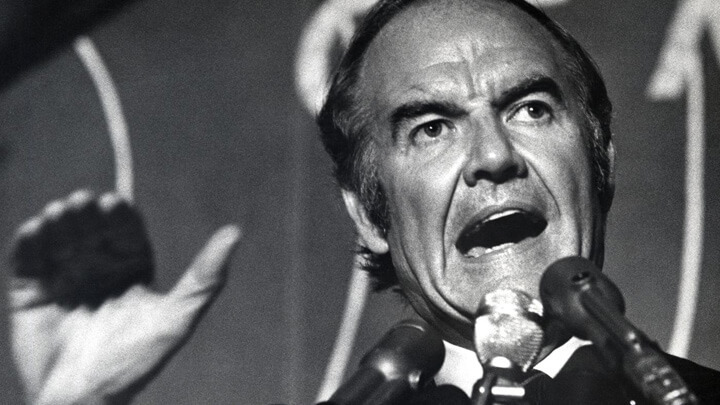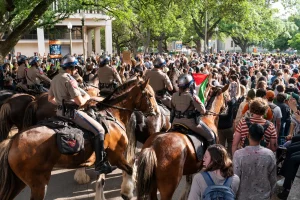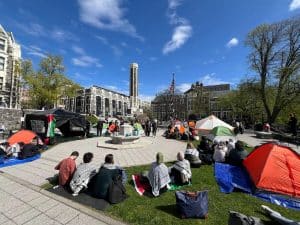The Democratic Party stumbled off the starting block in Iowa and fell flat on its face. The arcane caucus process was drawn out over several days. Voting software failed, and three sets of results told different stories. As of this writing, Pete Buttigieg led in state delegate equivalents, Bernie Sanders in popular votes. This all served to fan the flames of suspicion—is the Democratic Party putting its thumb on the scale again? Is Sanders being sabotaged?
For many socialists who are backing the Sanders campaign, this is proof that the Democratic primaries are a “class struggle election.” In this narrative, Sanders, representing the working class, is being fought tooth and nail by the establishment, which represents the bourgeoisie. But this is a misreading of the Democratic Party and its internal dynamics.
In 1972, George McGovern ran what was considered a left-wing campaign against President Richard Nixon. McGovern was known as the candidate of “amnesty, abortion, and acid.” (This was unfair, although he did favor the decriminalization of marijuana.) He was the only major-party candidate to campaign on ending the war in Vietnam, and he proposed a “demogrant” that would give every household $1,000 a year—a prototype of universal basic income. He lost the popular vote by 23 points, a stunning rebuke by Nixon’s “silent majority.” In the aftermath, the Democratic Party drew a simple lesson: left-populist candidates lose elections. Since then, “electability” has been the focus. The victories of Jimmy Carter and Bill Clinton, Southern moderates, cemented this viewpoint within the party elite.
McGovern panic has functioned as a sort of “immune system” for the Democratic Party. Jesse Jackson’s 1988 campaign was seen as doomed because a Black leader could not win. In 2004, Howard Dean made an antiwar bid but lost to moderate John Kerry. Barack Obama was the next “movement” candidate to win the nomination, but he proved to be a consummate centrist. And the Democratic National Committee worked to make Hillary Clinton the nominee in 2016.
As a result, neoliberalism has been the Democratic Party’s bread and butter. Clinton’s triangulation and Obama’s technocratic style led to welfare reform and a health care plan devised by Republican lobbyists as their major accomplishments. Democrats have been tied to unpopular free trade plans and foreign wars. Lacking another charismatic phenom like Obama, the Democrats have few options with mass appeal.
Mainstream Democrats have made “defeating Trump” their main narrative for the 2020 elections. They hope that the president’s low approval ratings will pull an “empty suit” president—even Joe Biden, who shows his advanced age badly—into the Oval Office. We cannot forget that McGovern ran against Nixon, whom Hunter S. Thompson called “a political monster straight out of Grendel.” Nixon would be forced to resign, and Trump’s brazen self-interest creates unsettling parallels. And without an obvious front-runner in the Democratic primaries, Sanders triggers a much worse case of McGovern panic than he did in 2016.
Political operatives blamed McGovern’s loss on his “extremism.” This must apply to Sanders, who has used the term “democratic socialist” to describe himself. But a deeper look at McGovern’s loss in 1972 shows that he was also abandoned by the Democratic Party. The AFL-CIO refused to endorse a presidential candidate, and his primary rivals failed to coalesce around him. His former primary opponents even appeared on Meet the Press during the Democratic Convention and criticized McGovern. Down-ballot candidates campaigned independently and won a net of two Senate seats and a House majority despite the Electoral College landslide. McGovern’s initial choice as running mate, Tom Eagleton, was undermined by rumors about his mental-health history and forced to resign. “Party unity” in the capitalist party was broken not by the extremist candidate but by the centrists.
If Sanders wins the nomination, his support from the Democratic party will be minimal. There are forces that would prefer a Trump reelection to Sanders in office. He has support from some unions, particularly public employees and teachers. But presidential elections can turn on a handful of groups choosing to stay home.
There is one area, though, where Sanders’s supporters have failed to learn a lesson from the 1972 election. They often argue that Sanders will draw out support from the youth and other disaffected voters. This strategy failed McGovern, who courted the votes of the youth radicalization of the late 1960s with his antiwar positions. It also failed in the December 2019 election in the UK, where Jeremy Corbyn’s Labour strategy had similar expectations. Even the results from Iowa so far have not shown an elevated turnout.
Even if Sanders can win the general election, he will come up far short of his ambitious program. When the Democratic Party wins a majority in Congress, the balance of power is always made up of conservative members from “swing” districts. This gives moderates control over what legislation will pass. Medicare for All is impossible given the lack of support in the Senate. A Green New Deal is unlikely unless it takes the form of a pro-corporate energy and infrastructure plan. He may be able to bring some pro-union legislation to bear, although this is likely to be more symbolic than significant; under Obama, the Employee Free Choice Act had simply disappeared into thin air. This is a best-case scenario, in which Sanders is not shut out by an intractable Congress.
The key to understanding this situation is that the Democratic Party is not a site of class struggle but of class collaboration. The ruling class has used it to co-opt many popular causes. From labor to civil rights, from antiwar to feminism, from the environmental movement to Black Lives Matter, the Democrats have earned the nickname “the graveyard of social movements.” Trying to bring the social movements of the 2010s that began with Occupy Wall Street into the trap has caused some discomfort.
In the 1980s, Sanders hung a picture of socialist leader Eugene V. Debs in City Hall in Burlington, Vermont. In 2019 he described “democratic socialism” in terms of Franklin Roosevelt and the New Deal. This was no accident: Sanders wanted to signal that his candidacy is not an existential threat to capitalism. Debs was a tireless fighter for the working class. He was a revolutionary who led an independent socialist party. Roosevelt was a New York aristocrat whose policies saved capitalism. The New Deal was bitter medicine for capitalism, but like medicine it was meant to heal the patient.
But then, why is the opposition so stiff? The reason is straightforward: capital has no intention of returning to an era of Keynesian solutions. This has been a clear pattern around the world. The ruling class would rather see nationalistic right populists in power, as long as they enforce the regime of austerity. Sanders represents a wing of the Democratic Party that is demanding a deal that is not on the table.
This is why the demands Sanders puts forward seem so quixotic to Democrats. His appeal is in making reform promises that, moderate though they are, will not be brought to fruition. And despite his efforts to make himself appear safe, he is not considered a reliable executive to run an imperialist superpower. This is what lies behind his McGovern problems.
It is a mistake to think that socialists can win this struggle by making Sanders the nominee or even president. As long as the struggle is on the terrain of the Democratic Party, it can never be a question of class power. The working class can find its own power only when it organizes in its own formations—fighting unions, class-independent movements in the streets, and ultimately a revolutionary party of its own.










